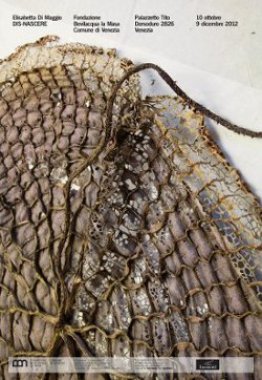For the first time, the Bevilacqua La Masa is to witness the work of Elisabetta Di Maggio (born in Milan in 1964) in a solo exhibition, the ideal occasion for the completion of a mural begun in 2004 and left unfinished due to the birth of her son Andrea.
The exhibition will cover the entire range of techniques developed by the artist over approximately the last ten years.
At first sight, Elisabetta Di Maggio's works appear as decorative patterns. In fact, her method begins above all with embroidery, moving on from what is a highly precise, typically female skill. One of her first major works was a trousseau, simulating in paper what girls used to do on cloth. On looking more carefully, though, you see nothing romantic or specifically feminine in her works. They are dense, bearers of a sense of the hardness in life, bitter and cruel.
Usually, with the precision of a surgeon, the artist cuts through sheets of tissue paper, small or enormous vegetable leaves, soap and other surfaces, including plaster. With a set of scalpels, she spends hours cutting these materials, obtaining a sculpted geography that alludes to many things. All of them, though, share a single theme - the form taken by life as it spreads and organises itself.
It is there, in the themes and plots underlying the embroidery, that we see the way the roots of certain vegetables expand, the way the cells of living tissue develop, the way different kinds of towns unravel their networks of roads and electric-like circuits, only to discover the pattern taking the form of a butterfly's flight.
The artist thus takes her subjects from the real world, starting from anthropological, botanical and all kinds of scientific illustrations and street maps. In this perspective, even the allusion to domestic upholstery, with its rose and flower patterns, becomes a manifestation of how nature works - in this case via the dexterity and taste of man.
And so, in the great surfaces of paper, the structures made of pins, the preparatory drawings and the entire repertoire of Elisabetta Di Maggio, the rite of life and its inevitable propagation are repeated, with the dry branches being left sometimes to die and sometimes to live with, indeed, an exaggerated vitality in the collateral branches.
The entire work thus takes on the flavour of a reflection on our own existing as parts of a whole that tends to repeat certain laws of fractal growth. Human life is portrayed as made up of poetry and pleasure, but also of danger, a constant precariousness and the absence of peace. In this sense, the artist strips the flesh off life, reducing it to a skeletal form to convey the sense of being 'dis-born', taking it back to an original preconscious state with the ossification of existential processes and hence the freezing of malaise. The only way to allay the anguish of being lucid about who we are and where we come from seems to be action, the application of doing as a form of both meditation and, at the same time, anaesthetic.

